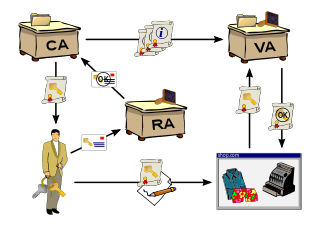Kerberos is a computer-network authentication protocol that works on the basis of tickets to allow nodes communicating over a non-secure network to prove their identity to one another in a secure manner. Its designers aimed it primarily at a client–server model, and it provides mutual authentication—both the user and the server verify each other's identity. Kerberos protocol messages are protected against eavesdropping and replay attacks.
The Lightweight Directory Access Protocol is an open, vendor-neutral, industry standard application protocol for accessing and maintaining distributed directory information services over an Internet Protocol (IP) network. Directory services play an important role in developing intranet and Internet applications by allowing the sharing of information about users, systems, networks, services, and applications throughout the network. As examples, directory services may provide any organized set of records, often with a hierarchical structure, such as a corporate email directory. Similarly, a telephone directory is a list of subscribers with an address and a phone number.
An authenticator is a means used to confirm a user's identity, that is, to perform digital authentication. A person authenticates to a computer system or application by demonstrating that he or she has possession and control of an authenticator. In the simplest case, the authenticator is a common password.
Trusted Computing (TC) is a technology developed and promoted by the Trusted Computing Group. The term is taken from the field of trusted systems and has a specialized meaning that is distinct from the field of Confidential Computing. The core idea of trusted computing is to give hardware manufacturers control over what software does and does not run on a system by refusing to run unsigned software. With Trusted Computing, the computer will consistently behave in expected ways, and those behaviors will be enforced by computer hardware and software. Enforcing this behavior is achieved by loading the hardware with a unique encryption key that is inaccessible to the rest of the system and the owner.
In cryptography, a key-agreement protocol is a protocol whereby two or more parties can agree on a key in such a way that both influence the outcome. If properly done, this precludes undesired third parties from forcing a key choice on the agreeing parties. Protocols that are useful in practice also do not reveal to any eavesdropping party what key has been agreed upon.
A virtual private network (VPN) extends a private network across a public network and enables users to send and receive data across shared or public networks as if their computing devices were directly connected to the private network. The benefits of a VPN include increases in functionality, security, and management of the private network. It provides access to resources that are inaccessible on the public network and is typically used for remote workers. Encryption is common, although not an inherent part of a VPN connection.

Matchmaking is the process of matching two or more people together, usually for the purpose of marriage, in which case the matchmaker is also known as a marriage broker. The word is also used in the context of sporting events such as boxing, in business, in online video games and in pairing organ donors.

A public key infrastructure (PKI) is a set of roles, policies, hardware, software and procedures needed to create, manage, distribute, use, store and revoke digital certificates and manage public-key encryption. The purpose of a PKI is to facilitate the secure electronic transfer of information for a range of network activities such as e-commerce, internet banking and confidential email. It is required for activities where simple passwords are an inadequate authentication method and more rigorous proof is required to confirm the identity of the parties involved in the communication and to validate the information being transferred.
In cryptography, a certificate authority or certification authority (CA) is an entity that stores, signs, and issues digital certificates. A digital certificate certifies the ownership of a public key by the named subject of the certificate. This allows others to rely upon signatures or on assertions made about the private key that corresponds to the certified public key. A CA acts as a trusted third party—trusted both by the subject (owner) of the certificate and by the party relying upon the certificate. The format of these certificates is specified by the X.509 or EMV standard.
In computer security, a key server is a computer that receives and then serves existing cryptographic keys to users or other programs. The users' programs can be running on the same network as the key server or on another networked computer.
Greylisting is a method of defending e-mail users against spam. A mail transfer agent (MTA) using greylisting will "temporarily reject" any email from a sender it does not recognize. If the mail is legitimate, the originating server will try again after a delay, and if sufficient time has elapsed, the email will be accepted.

Internet security is a branch of computer security. It encompasses the Internet, browser security, web site security, and network security as it applies to other applications or operating systems as a whole. Its objective is to establish rules and measures to use against attacks over the Internet. The Internet is an inherently insecure channel for information exchange, with high risk of intrusion or fraud, such as phishing, online viruses, trojans, ransomware and worms.
DoYouDo, Inc. is a Beverly Hills, California company that owns the patent to an anonymous matching service designed to detect mutual attraction between friends or acquaintances based on confidential lists they create of people they are interested in. On September 7, 1999, Israeli businessmen Gil S. Sudai and David J. Blumberg patented the methodology, which represented a departure from the approaches employed by other online dating services and dating systems. It focused on matching up people who already had a non-romantic relationship offline, rather than matching up strangers, and was designed to help solve the problems associated with unwanted romantic overtures on the one hand, and inhibition resulting from fears of unrequited love on the other.
The eCRUSH network consisted of two sites: eCRUSH.com and eSPIN.com. The network was acquired by Hearst Media on December 31, 2006. The original eCRUSH site was opened on Valentine's Day, 1999 in Chicago by Clark Benson and Karen DeMars Pillsbury. It pre-dated social networking sites such as Friendster.com, MySpace.com and Facebook.com.
Secure messaging is a server-based approach to protect sensitive data when sent beyond the corporate borders, and it provides compliance with industry regulations such as HIPAA, GLBA and SOX. Advantages over classical secure e-mail are that confidential and authenticated exchanges can be started immediately by any internet user worldwide since there is no requirement to install any software nor to obtain or to distribute cryptographic keys beforehand. Secure messages provide non-repudiation as the recipients are personally identified and transactions are logged by the secure email platform.
Direct Anonymous Attestation (DAA) is a cryptographic primitive which enables remote authentication of a trusted computer whilst preserving privacy of the platform's user. The protocol has been adopted by the Trusted Computing Group (TCG) in the latest version of its Trusted Platform Module (TPM) specification to address privacy concerns. ISO/IEC 20008 specifies DAA, as well, and Intel's Enhanced Privacy ID (EPID) 2.0 implementation for microprocessors is available for licensing RAND-Z along with an open source SDK.
Exchange ActiveSync is a proprietary protocol designed for the synchronization of email, contacts, calendar, tasks, and notes from a messaging server to a smartphone or other mobile devices. The protocol also provides mobile device management and policy controls. The protocol is based on XML. The mobile device communicates over HTTP or HTTPS.
Invisible mail, also referred to as iMail, i-mail or Bote mail, is a method of exchanging digital messages from an author to one or more recipients in a secure and untraceable way. It is an open protocol and its java implementation (I2P-Bote) is free and open-source software, licensed under the GPLv3.
A mailbox provider, mail service provider or, somewhat improperly, email service provider is a provider of email hosting. It implements email servers to send, receive, accept, and store email for other organizations or end users, on their behalf.
Autocrypt is a cryptographic protocol for email clients aiming to simplify key exchange and enabling encryption. Version 1.0 of the Autocrypt specification was released in December 2017 and makes no attempt to protect against MITM attacks. It is implemented on top of OpenPGP replacing its complex key management by fully automated unsecured exchange of cryptographic keys between peers.


